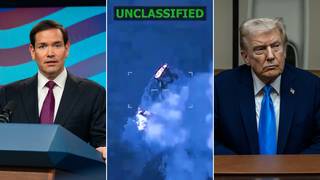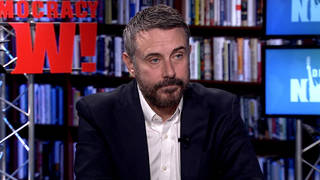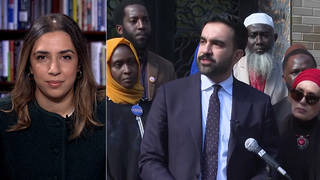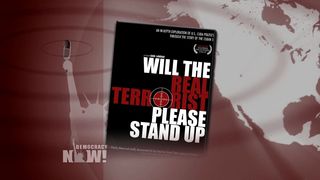
Topics
Guests
- John Dingesauthor of The Condor Years: How Pinochet and His Allies Brought Terrorism to Three Continents. He was stringer for the Washington Post during the Pinochet dictatorship, and later assistant editor on the Washington Post Foreign Desk, and deputy senior foreign editor and then managing editor for NPR. He is a professor at the Columbia University Graduate School of Journalism and has created two investigative reporting centers in Chile.
A historic trial underway in Argentina is set to reveal new details about how Latin American countries coordinated with each other in the 1970s and '80s to eliminate political dissidents. The campaign known as “Operation Condor” involved military dictatorships in Argentina, Bolivia, Brazil, Chile, Paraguay, Peru and Uruguay. They worked together to track down, kidnap and kill people they labeled as terrorists: leftist activists, labor organizers, students, priests, journalists, guerrilla fighters and their families. The campaign was launched by the Chilean dictator Augusto Pinochet, and evidence shows the CIA and former U.S. Secretary of State Henry Kissinger were complicit from its outset. We're joined by John Dinges, author of “The Condor Years: How Pinochet and his Allies Brought Terrorism to Three Continents.” The book brings together interviews and declassified intelligence records to reconstruct the once-secret events. [includes rush transcript]
Transcript
JUAN GONZÁLEZ: An historic trial that began Tuesday in Argentina is set to reveal new details about how six Latin American countries coordinated with each other in the 1970s and 1980s to eliminate political dissidents. The campaign, known as Operation Condor, involved military dictatorships in Argentina, Bolivia, Brazil, Chile, Paraguay, Peru and Uruguay. They worked together to track down, kidnap and kill people they labeled as terrorists: leftist activists, labor organizers, students, priests, journalists, guerrilla fighters and their families.
The campaign was launched by the Chilean dictator Augusto Pinochet, and evidence shows the CIA and former Secretary of State Henry Kissinger were complicit from its outset. At least 25 military generals are facing charges, and more than 500 witnesses are expected to testify during the trial. Last August, an Argentine federal judge issued a formal request to the Obama administration’s Justice Department to make Kissinger himself available for questioning. The Obama administration did not respond.
AMY GOODMAN: This trial is taking place in Buenos Aires, the site of a former auto mechanic shop turned torture camp. Argentina is where the greatest number of killings of foreigners was carried out under Operation Condor. All of this comes just weeks after Uruguay’s Supreme Court struck down a law that had allowed similar prosecutions in that country.
Well, for more, we’re joined by John Dinges, author of The Condor Years: How Pinochet and His Allies Brought Terrorism to Three Continents. The book brings together interviews and declassified intelligence records to reconstruct the once-secret events. Before that, Dinges was with NPR and worked as a freelance reporter in Latin America. He is currently a professor at the Columbia School of Journalism.
John Dinges, welcome to Democracy Now!
JOHN DINGES: Yeah, nice to be here. Thanks.
AMY GOODMAN: Talk about the significance of this trial that’s now underway in Argentina.
JOHN DINGES: Well, there have been several trials, and this goes back to when Pinochet was arrested in London in 1998. That unleashed an avalanche of evidence that went across Europe and led to trials in many places—Rome, Paris, Argentina, Chile—but all of them much smaller than this one. This one has 25 people accused. Unfortunately—or fortunately, who knows?—many of the people who were involved in this have already died, they’re getting old, of the top leaders. But this is 25 Argentinians and one Uruguayan, all of whom were in military positions, all of whom were involved directly with the actions of Operation Condor.
This is historic in the sense that we’re going to hear from 500 witnesses. And really, in the Latin American legal system, it’s unusual. It’s really only coming to the fore now that you hear witnesses, as opposed to just seeing them give their testimony to judges in a closed room, and then later on people like me might go and read those testimonies, but really it doesn’t become public. This is all public. And apparently, a lot of it is being videotaped. So this is—this is the first time that the general public is going to hear the details of this horrible, horrible list of atrocities that killed so many people.
JUAN GONZÁLEZ: And, John, for folks who have never heard of Operation Condor or know little about it, the origins of it, how it began, and the nations or the governments that spearheaded it, could you talk about that?
JOHN DINGES: Well, it is a Chilean invention. Augusto Pinochet had dominated his opposition by—the coup was in 1973; by 1974, there was no internal opposition to speak of. But many of the people who had been part of the previous government, that he had overthrown, had gone overseas. There was a very major, important general who was living in Argentina. Political leaders, for example, Orlando Letelier, the former foreign minister and former ambassador to the United States, somebody who would have lunch with Henry Kissinger, was living in Washington. People were spread around, in Europe and all over Latin America, and Pinochet wanted to go after them. And so he mounted Operation Condor.
And he convinced the other countries—Brazil, Uruguay, Argentina, Bolivia and Paraguay—to go along with him, with the argument that there are these guerrilla operations that are a threat to all of them. And there was indeed a guerrilla operation, called the Revolutionary Coordinating Junta, of people who were taking up arms against these governments. And the idea was that they would cooperate in tracking these people down. And they did.
Most of the—the biggest part of the exiles were in Argentina, because Argentina was the last country to give up its civilian government. It wasn’t a dictatorship until March of 1976. And this was created in late 1975. So they were all geared up. And when the coup happened in Argentina, they began killing hundreds of people, of these foreigners. And it’s interesting that you mentioned the Automotores Orletti. This is that auto repair shop that was used as a torture center, and that’s where they kept the international prisoners.
AMY GOODMAN: We, Democracy Now!, went there, visited this shop. I want to read from a declassified record of a CIA briefing that shows that American officials were aware that Latin intelligence services were casting their net wide in Operation Condor. It says, quote, “They are joining forces to eradicate 'subversion' … a word which increasingly translates into nonviolent dissent from the left and center left.”
It goes on to another document that you obtained, John Dinges, that’s from the Chilean secret police, known as the DINA. It details the number of dead and disappeared compiled by Argentine intelligence. The cable, sent by DINA’s attaché to Buenos Aires, says he’s, quote, “sending a list of all the dead,” which included the official and unofficial death toll. Between 1975 and mid-’78, he reported, quote, “they count 22,000 between the dead and the disappeared.” Talk about the the number of the dead and what the U.S. knew.
JOHN DINGES: Well, let’s do the U.S. first. The United States, in this period, the 1970s, was a major sponsor of the military dictatorships that had overthrown some democracies, some faltering civilian governments. Whatever it was, the result was governments, like Videla, like Pinochet, like Banzer in Bolivia, who were killing their citizens with impunity. The United States knew about the mass killing. We had this kind of schizophrenic, Machiavellian attitude toward it. We really don’t want these communists to be taking over governments, and we fear that democracy is leading to communist governments. Indeed, a leftist government led by Salvador Allende installed a democratically elected, civilian and revolutionary government in Chile, and that’s why—and Pinochet overthrew that government. The United States was deathly fearful that this would spread in Latin America, and so supported the coming of dictatorships.
When they began mass killings, the United States was aware of these mass killings. When they—they learned of Condor shortly after it was created. There’s no evidence that they knew about it the day it was created. The earliest evidence is a couple months after it began its operations. But they certainly knew these things were happening. And if you look at the meetings, the transcripts of the meetings between Henry Kissinger and these leaders, both in Argentina and in Chile, where we have the records, what do they say in private? You know, “We support what you are doing. We understand that you have to assert your authority. Try your best to release some prisoners, because I’m under a lot of pressure in Congress, because the Democrats are trying to make me, you know, defend human rights. Do the best you can, but I understand what you’re doing.”
And in one case, two weeks after Kissinger visited Santiago, there was a—the second major meeting of all the Condor countries to discuss Condor. And at that meeting, in June 1976, they approved operations for assassination outside of Latin America. The first assassination that occurred was in Washington, D.C. Orlando Letelier, the former foreign minister, was killed on the streets of Washington.
AMY GOODMAN: This is an astounding story. You wrote a book about it, in fact.
JOHN DINGES: And this is—I’ve written actually two books, one about the assassination, in which I, for the first time, wrote a chapter on the discovery of Operation Condor. I didn’t have a lot of detail. In fact, I was misled by the State Department, to a certain extent.
And then, years later, after Pinochet was arrested in London, a flood of documents, including many, many—60,000 pages of documents released by—ordered released by President Clinton, I was able to then, you know, really dig in and understand it from the point of view of the United States. But also, many, many documents were revealed in Latin America. And that is, I think, even more important, because if we just had U.S. documents, it’s always subject to: “Well, that’s the U.S. view of these things.” What was really going on in those Latin American governments—
AMY GOODMAN: But explain how Ron—how Orlando Letelier and his assistant, Ronni Moffitt, were killed in the streets of Washington, D.C., in the United States, in 1976.
JOHN DINGES: Pinochet began this operation shortly after that meeting with Kissinger. Within a month, he gave the order approving this. They sent an agent who had been working for DINA for several years named Michael Townley, an American. I don’t believe it was any accident that they made an American working for them the hit man on this, because, obviously, as soon as suspicion was cast on them, they said, “Oh, this guy was working for the CIA.” And a lot of people like to believe the CIA does all these things. In fact, both the extreme right and the extreme left were saying, “Oh, it was the CIA who did it.” There’s no evidence that Townley was working for the CIA, but he certainly was working for the Chileans.
He allied with some Cubans up in New Jersey, anti-Castro Cubans. They came down to Washington. They—Townley crawled under the car, installed a bomb that he had constructed himself. It was run by one of those old beeper devices. They followed the car down Massachusetts Avenue, and at Sheridan Circle, right outside near the Chilean embassy, they pushed the button, killed him. Ronni Moffitt was the wife of Michael Moffitt, who was actually Orlando’s assistant. She was sitting in the front seat, and that’s why she was killed. Michael survived, and Orlando of course was devastated, died immediately.
AMY GOODMAN: And Townley went to jail for a few years. And then—
JOHN DINGES: Townley—the Chileans turned him over. The story of how we solved this case is incredible. The presumption was that the United States is not going to investigate this very strongly. Everybody that thought that was wrong. The FBI did—made an enormous investigation, solved the case, got pictures of the people. And that’s the long story that I tell in the book. When they identified the people that had come up to the United States to carry this out, they went down to Chile, asked for the cooperation of the Pinochet government. And Pinochet eventually—they had two choices: Either they were going to kill Townley—and there’s evidence that that was one of their plans—or they had to turn him over. And they eventually turned him over. He was taken to the United States, and he began to give testimony. And another flood of information came from Michael Townley. Townley still lives in the United States. He served only five years in prison.
AMY GOODMAN: And then went into witness protection.
JOHN DINGES: And was in witness protection for a while. I understand he’s not anymore in witness protection. He lives in the Midwest. And he’s—he has cooperated. I don’t know whether there’s any remorse on his part, but he has cooperated with many investigations since his imprisonment.
JUAN GONZÁLEZ: John, I’d like to ask you about an unusual figure that you talk about in the book and his role in trying to end Operation Condor: Ed Koch, the recently deceased mayor of New York, who was then a young liberal congressman and who began asking all kinds of questions about what was going on and angered our own government. Could you talk about that?
JOHN DINGES: Ed Koch, a beloved figure in this city, and certainly everybody that’s dealt with him has had the same experience. And I was reporting this story. He was very cooperative with me. And he came to my book party, so I love him, too.
Ed Koch was a congressman. He spearheaded a bill, an amendment to a bill, to cut off military aid to Uruguay. The Uruguayans were members—this was 1976. The Uruguayans were members of Operation Condor. And the CIA discovered—and I think the evidence is that they discovered because they were—they talked about it in front of them, that they said they were going to get the Chileans to go up to Washington to kill Koch. And whether that actually was put into action, we don’t know. But George Bush, who was head of the CIA at the time, called up Ed Koch and said, “Ed” — and it’s wonderful to hear Ed Koch tell this story — “I’ve got to tell you something: There’s a plot to kill you.” And Ed Koch said, “Are you going to provide me protection?” They said, “No, no, no. That’s not our job. We’re the CIA. We’re just telling you, and it’s up to you to provide your own protection.” Ed Koch didn’t know this was Operation Condor. He just thought this was some crazy people from the dictatorship.
Later on, in my investigation, I was—I actually talked to one of the people who was involved in this, one of the Uruguayans, and who—it was a Condor operation. It was kind of a typical one, even though it didn’t actually kill anybody, luckily. But it was the modus operandi. In order to cover their tracks, one country would use another country’s nationals to do their dirty work in the operations that were planned outside of Latin America. Inside of Latin America, you had a much more systematic and effective way of operating, in which they would just track down each other’s dissidents in whatever country they happened to be—Peru, Brazil, Uruguay, mainly in Argentina. And then they would—the methodology was simple: capture them, kidnap them, torture them, kill them, make their bodies disappear. Very few victims have survived Operation Condor, almost none. It’s very difficult to find a survivor.
JUAN GONZÁLEZ: And yet, today in Latin America, many of the leaders of the new populist governments were folks who had emerged from some of the very groups that Condor was tracking. And Uruguay especially, a former Tupamaro. And throughout the region, those dissidents now are part of the governing apparatus of their countries.
JOHN DINGES: I was in Bolivia just two weeks ago, and I interviewed one of the—one of the people in the Ministry of Communications, and a man who’s among the many, many, many indigenous people who are in the Morales government. And he described how his father had been a prisoner, had been in Chile as an exile. When the military coup happened, he was imprisoned and kept prisoner for seven months and tortured. And I talked to, in that same office, another person who also had been involved in the Bolivian resistance in the 1980s, going back with the group that had fought together with Che Guevara in the 1960s. His father had been involved with them.
These are revolutionaries, but they are a different brand of revolutionaries. They are as dedicated, I think, but they’re not taking up arms. I really believe that they realize that that did not lead to successful revolutions, and so I’m much more optimistic about what’s going on with the—with this current group of governments.
AMY GOODMAN: Finally, a State Department cable, 1978, begins—the jacket of your book, says, “Kissinger explained his opinion [that] the Government of Argentina had done an outstanding job in wiping out terrorist forces.” The significance of the judge calling for Kissinger’s testimony and the Obama administration not responding?
JOHN DINGES: They have asked for Kissinger to give testimony many times. And in my book, I quote the one time where he actually responded to a petition from France, I believe it was. And he basically denied everything. This is very frustrating. I was able to—it was clear to me that, there’s no other word for it, these were lies. I mean, the documents say one thing; Kissinger said another thing. And he knew what those documents said. It’s not—the United States has never allowed any of its officials to face trial in other countries. We are not a member of the ICC. There’s never—
AMY GOODMAN: The International Criminal Court.
JOHN DINGES: The International Criminal Court. There’s never been any participate—there’s never been any trials that have brought Americans in the dock. There was an attempt in Italy; of course, all of those people were gone. The United States, for one reason or another, Democrats and Republicans, protect our own human rights criminals when it’s involving human rights crimes outside of the United States. It’s just the way it is.
AMY GOODMAN: Would you describe Henry Kissinger in that way, as a human rights criminal?
JOHN DINGES: Yes, absolutely.
JUAN GONZÁLEZ: And the relevance of this history of farming out the battle against terrorism, and so you could have no finger marks—no fingerprints of your own involvement to the current war against terrorism in the United States?
JOHN DINGES: Well, I wrote—I was writing chapter one, when 9/11 happened, in my house in Washington. And as I finished the book—and I actually end with a reference to 9/11—I said this is not something that we’re condemned to repeat. And I was making the comparison between the war on terror in the 1970s and the current war on terror that was launched by President Bush. I thought we were going to—we had learned the lesson, that you don’t imitate the methods of your enemies and—or those who had been shown to be human rights criminals. Unfortunately, we crossed that line, I think, many times.
The current discussion about drones, I think, is very frightening, because I’m having a hard time distinguishing between what they did with Operation Condor, low-tech, and what a drone does, because a drone is basically going into somebody else’s country, even with the permission of that country—of course, that’s what Operation Condor did, in most cases: You track somebody down, and you kill them. Now, the justification is: “Well, they were a criminal. They were a combatant.” Well, that may or may not be true, but nobody is determining that except the person that’s pulling the trigger.
I just think that this has to be something that we discuss. And maybe trials like this, going back to the ’70s, people say, “Well, that was the dictatorships of the 1970s.” But the tendency of a state to feel that they can move against their enemies in the most effective way possible is still there, and it is certainly not limited to dictatorships.
AMY GOODMAN: We want to thank you, John Dinges, for being with us. John Dinges is author of The Condor Years: How Pinochet and His Allies Brought Terrorism to Three Continents. Before that, he was with National Public Radio, NPR, worked as a freelance reporter in Latin America, is currently a professor at the Columbia School of Journalism.
This is Democracy Now! When we come back, we’ll be joined by filmmaker Dave Riker and actress Abbie Cornish about a new film about human smuggling on the border, called The Girl. Stay with us.












Media Options